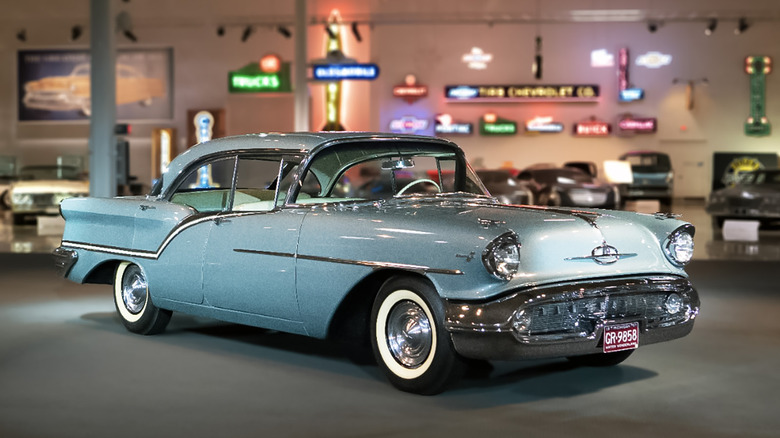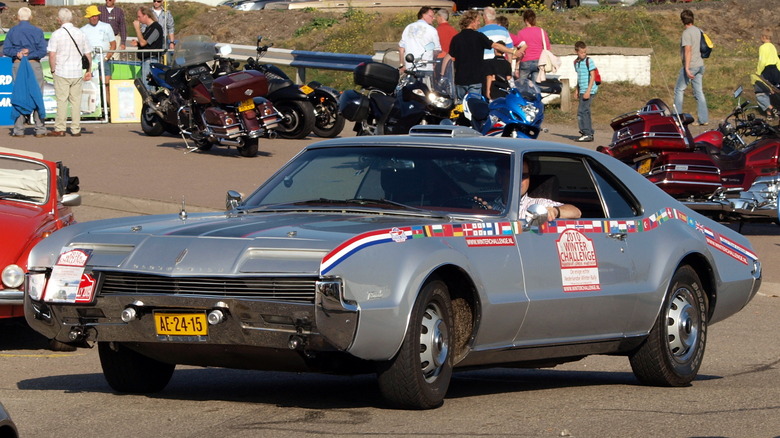Important Moments In The History Of The Oldsmobile
When the last Oldsmobile rolled off the production line in 2004, it marked the end of the line for a remarkable automaker that made significant contributions to the automotive world in its 107-year existence. Under the General Motors umbrella for most of its history (it was founded in 1897 and acquired by GM in 1908), Oldsmobile went through several phases, each with varying levels of success, but each era was marked by either a special performance model or technical innovation.
Over the years, Oldsmobile struggled with its brand identity, and by the early 1990s, when it was launching models like the aspirationally named Achieva sedan, its offerings were not especially attractive, even if they were technically not bad cars. Its image through the 1990s was also affected by its diesel engine models, which it started launching as a response to the 1970s and 1980s oil crisis, but they were plagued by problems and are today considered one of the company's biggest failings.
The 1992 Oldsmobile Achieva is a great example of the kind of unremarkable cars the company was making when it went out of business. Its design was bland and it just couldn't compete with models from Japanese rivals. The manufacturer improved it over subsequent model years, but it was still a far cry from what it was making a few decades prior when it played a bigger role in the market.
Oldsmobile's Glory Days
Turn the clock back to the end of the Second World War, though, and Oldsmobile was doing great. One of the most iconic models in the company's history is the 1949 Oldsmobile 88, an early pioneer of the style of car design that would come to define the 1950s. The model was also known as the Rocket 88 after its Rocket V8 engine, one of Olds' biggest technical contributions to the automotive scene.
The Rocket V8 engine's biggest innovation was its overhead cam design, which allowed it to produce a lot of power for the day. Early versions of the engine made around 135 horsepower, but by the mid-1950s, power levels had gone up to over 300 horsepower. This enabled cars like the mid-1960s Oldsmobile 442 to accelerate from 0 to 60 mph in under 8 seconds, a real achievement even for a muscle car of the time, although this isn't surprising since Oldsmobile made plenty of good muscle cars in the 1960s and 1970s.
[Image by AlfvanBeem via Wikimedia Commons | Creative Commons CC0 1.0 Universal Public Domain Dedication]
First Mass-Produced Automatic Transmission
Another important innovation introduced by Oldsmobile was the Hydra-Matic automatic transmission. The manufacturer is credited with being the first to put an automatic gearbox in a mass-produced car when, in 1940, it launched the 90 model, which was available with an optional self-shifter.
It had three forward gears, but that was the norm for the early 1940s when there were still cars with two gears running around. Many drivers preferred it because they didn't want to change gears themselves (essentially starting the slow demise of the manual gearbox), but it also provided much smoother shifts than even a skilled driver could achieve in a manual car. The transmission was co-developed with General Motors, but Oldsmobile put it into production first which ultimately led to the much wider adoption of automatics across GM's other brands.
Oldsmobile is also known for its 1966 Toronado, which, aside from looking like nothing else on the road at the time, was also the first series production front-wheel drive car made in America since the 1930s Cord 810. The Toronado was sold as a personal luxury car, so it needed the motivation of a huge 425 cubic-inch (7-liter) V8 engine, and it also had to feel effortless to drive, so it got a Hydra-Matic transmission that was specially adapted for the front-wheel drive application.

